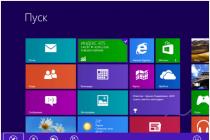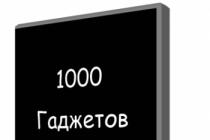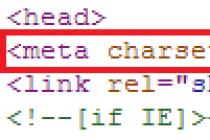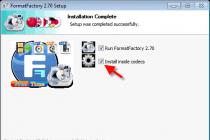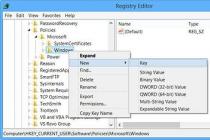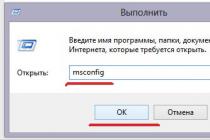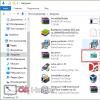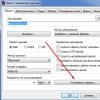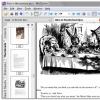The fifth numbered part of Grand Theft Auto, having successfully emptied the wallets of console players, after a long delay, came to personal computers... A large open world and a trio of crazy bandit heroes await those who are ready to share their adventures. But today we will not talk about how GTA 5 can entertain the player, and not about the features of the gameplay. It's about performance and fine-tuning of graphic parameters.
GTA V offers a varied game world with completely different locations - business districts of the metropolis, slums, industrial complexes, mountain ranges, forests and deserts. Huge scale, great variety and detailed study of the environment. You can enjoy some of the views from the lower screenshots in 2560x1440 resolution.



The game pleases with good clear textures and relief surfaces, for which parallax mapping is actively used. Even ordinary lawns have a raised texture rather than using the usual painted texture.


As a clear illustration of the work of parallax mapping, we will give a screenshot, which, at the same time, clearly shows the work of the effect of changing the depth of field, which is actively used in the game.

Thanks to this lens effect, backgrounds are blurred, allowing for a more natural perception of the overall panorama.

The time of day and weather in the game changes. All objects cast correct soft shadows away from the sun. Cute sunrises and sunsets are complemented by rainbow effects.

The rendering range of objects is very high. By default, there is a noticeable change in the clarity of details as you move away from the camera. When using additional settings, the effect is leveled. This will be discussed in more detail below.

The general physics of the interaction of objects at the traditional level for such games. The surroundings are mostly static, but the pillars and display cases are beating. In story missions with big explosions, GTA 5 shows a good show with a bunch of bits and pieces. Management and physical model behavior of cars at the usual level for GTA, without any complications. In particular, only very serious damage affects the behavior of the machine. Externally, the cars look great - they shine in the sun, reflect all the surrounding buildings and lights on a smooth glossy surface.

Water surfaces look nice, but nothing more. In Watch Dogs, the water was more beautiful and livelier.

If we carry out general comparison graphics from Watch Dogs, you feel the technological edge of Ubisoft's game. But GTA V has a more meticulous attention to detail and more external variety.
The computer version of GTA 5 has a lot of graphical settings. Not all of them are clear to the average player. Some do not always directly indicate the effect they have on the overall picture quality. Sometimes the very meaning of the settings is lost due to the free translation of specific names. We will help you understand all their diversity. Let's see how the individual parameters affect the image, and how it affects performance. Based on the results, it will be possible to draw conclusions about which settings are most critical for performance, which ones hit the visual beauty a lot, and which ones do not. Such information will be relevant for owners of mid-range video cards and below. Based on our guide, it will be possible to select optimal ratio parameters, allowing you to increase productivity with minimal losses picture quality.
Those who want to get the most out of the game will not be forgotten either. There will be a comparison of different anti-aliasing modes. Let's find out which of them are the most successful, which are the most resource-intensive. Let's explore the impact of "advanced picture settings" that raise the graphics bar beyond what the game offers by default.
Test configurations
Basic test bench:
- CPU: Intel Core i7-3930K (3, [email protected], 4 GHz, 12 MB);
- cooler: Thermalright Venomous X;
- motherboard: ASUS Rampage IV Formula / Battlefield 3 (Intel X79 Express);
- memory: Kingston KHX2133C11D3K4 / 16GX (4x4 GB, [email protected] MHz, 10-11-10-28-1T);
- system drive: WD3200AAKS (320GB, SATA II)
- power supply unit: Seasonic SS-750KM (750 W);
- monitor: ASUS PB278Q (2560x1440, 27 ″);
- GeForce driver: NVIDIA GeForce 350.12;
- driver for the rest of the Radeon: ATI Catalyst 15.4 beta.
For testing processors, an additional test bench with the following configuration was used:
- processor # 1: Intel Pentium G3258 (3.2 GHz nominal, 3 MB);
- processor # 2: Intel Core i7-4770K (3.5 GHz nominal, 8 MB);
- motherboard: ASRock Z97 Anniversary (Intel Z97);
- memory: GoodRAM GY1600D364L10 / 16GDC (2x8 GB, 1600 MHz, 10-10-10-28-2T);
- system drive: ADATA SX900 256 GB (256 GB, SATA 6 Gb / s);
- power supply unit: Chieftec CTG-750C (750 W);
- monitor: LG 23MP75HM-P (1920x1080, 23 ″);
- operating system: Windows 7 Ultimate SP1 x64;
- GeForce driver: NVIDIA GeForce 350.12.
Testing was carried out using the built-in benchmark, which includes five test scenes. The average fps for each scene was taken into account and the final average value was calculated. To reduce the error, four benchmark runs were performed. Note that the test results are not displayed in the game, all data is saved at c: \ Users \ Username \ Documents \ Rockstar Games \ GTA V \ Benchmarks as a text file.
The logs also record the minimum fps for each test scene. But these values are too volatile and differ with each new run. At the same time, even in the case of real "lags", noticeable to the naked eye, these values were slightly different from the minimum fps on the cards, which produced a smooth picture. We ended up using Fraps for additional monitoring. And the minimum fps on the graphs is the average minimum value based on the results of each of the four runs of the benchmark, recorded by the program.
When considering the impact of settings on performance, one video card will be used - unreferenced GeForce GTX 760 2GB with frequencies at the level standard versions... The order of testing is as follows: the configuration of the maximum graphics settings without anti-aliasing at a resolution of 1920x1080 is taken, one of the parameters is changed, performance is tested at different quality levels of this parameter, comparative visual materials are provided with a demonstration of the difference in picture quality. Then all parameters are set back to the initial maximum value, and the change of another parameter with the corresponding tests begins.
Actively ignoring constraints, which allows you to use the most difficult parameters. All tests were carried out in the DirectX 11 rendering mode, since this API has long been the main one, even for budget graphic solutions... But the game also supports DirectX 10.1 and DirectX 10.
The order of studying individual parameters corresponds to their order in the game menu. An exception was made for the shadow settings, of which there are several, and they are to a certain extent interconnected. After considering the main parameters of the graphics, we will move on to additional ones, where a phased joint inclusion of all items will be carried out.
The next stage of the article is comparative tests different AMD and NVIDIA video cards with high quality graphics. In the end, there will be testing of processor dependence using Intel CPUs of different price categories.
Anti-aliasing modes
The game supports FXAA and MSAA anti-aliasing. For users of GeForce video cards, TXAA anti-aliasing is also available. The latter is activated after enabling MSAA in the settings as an additional option. Urban surroundings and industrial landscapes are always replete with straight lines, so that the stepped edges of objects are clearly visible here. The stepped outlines of the car against the background of a light road surface are no less visible. So you can't do without anti-aliasing. You can evaluate the effect of activating different anti-aliasing methods in comparison with the mode without anti-aliasing from the lower screenshots.





The color saturation of the vehicle in the foreground changes slightly due to the subtle fog effect. We do not pay attention to this, we carefully study the surrounding objects and elements. For clarity, let's compare the same fragments of each screenshot.

I would like to note right away good quality FXAA works, which is not the case in all games. The worst effect of smoothing "steps" at the boundaries of objects is given by MSAA in 2x mode, which is quite expected. Switching multisampling to 4x mode improves the picture. The transition to TXAA provides even smoother edges. And from this point of view this mode most effective. But with it, the overall picture is blurred a little, the clarity of details is lost. Compare the pavement, grass and shingles in the larger screenshots - these are the elements that make the difference most clearly. The relief texture of the grass with TXAA is generally lost. FXAA gives you a clearer picture.
The best balance between anti-aliasing and clarity is provided by MSAA 4x. Note the crane and the neighboring house in the background. With MSAA, they are clearer, even the inscription on the poster appears, which is not at all visible with FXAA.
Note also that the game has an interesting parameter "MSAA for reflections". It is logical to assume that it affects the smoothing of the edges of reflections, which are most often seen on the surface of cars. In practice, we did not detect any difference in reflections with and without MSAA 4x. Perhaps we are talking about reflections on other surfaces. It is possible that the very effect of this anti-aliasing is poorly expressed.

Now is the time to take a look at how all of these modes affect performance. Experienced graphics card - GeForce GTX 760.

FXAA activation in relation to the mode without anti-aliasing gives drop fps only 4%. Enabling MSAA 2x in relation to the mode without anti-aliasing on the test card results in a performance drop of 21% in the minimum parameter and up to 30% in the average game frame rate. Changing to MSAA 4x gives a 16% reduction relative to the simpler multisampling mode. TXAA 4x is given 3-4% more heavily. If you additionally enable an anti-aliasing mode for reflections of a similar quality to MSAA 4x, then we get the frame rate on the same level as the TXAA mode, which is 46-57% lower entry level without AA.
FXAA has a good visual impact and minimal impact on performance. MSAA is slightly better in terms of clarity, but the performance losses are impressive. Such a serious decrease in fps may be due to insufficient memory. Even without anti-aliasing, the game demonstrates that it will use about 2.5 GB at a resolution of 1920x1080.
Population
Three points are related to the density of people on the streets of the city. These are Population Density, Population Variety and Distance Scaling. Each has its own scale with 10 gradations. The first two points are quite obvious - they regulate the number of people on the streets and the use of various models for them. Distance Scaling is probably the distance they will appear. We gradually reduced all parameters from the maximum to half (we will consider it 100% and 50%). After a few minutes of playing different modes there is a minimal difference in the number of people on the streets. Presumably, this also affects the traffic density on the roads. You don't notice any of this unless you deliberately focus on the task at hand.
At the bottom left is a screenshot of the mode when all parameters are at maximum. On the right is an image of a similar place when all three parameters are reduced to 50%.


We did not lower these parameters to zero, since even a change from 100% to 50% did not give any significant difference in the frame rate, which can be clearly seen in the lower graph.

Decreasing "population" and "diversity" has no effect. Changing the distance leads to a meager increase in fps. The result is expected, because a weak adjustment of the population density will not affect the workload GPU... This is more relevant for the CPU. Decreasing these parameters can have a positive effect on weak CPUs. More or less modern systems you can immediately set them to the maximum.
Texture quality
It's time to experiment with Texture Quality. As noted above, in Ultra-quality in Full HD without anti-aliasing, the game already consumes up to 2.5 GB of video memory. It is logical to assume that graphics cards with 2 GB may experience problems because of this. And reducing the quality of textures for ordinary users will seem the most obvious solution to increase productivity. But is it? Let's figure it out now.
First, let's compare the image quality at the highest, highest and standard texture levels.


Texture quality very high


Texture quality high


Texture Quality Normal
Not everything is different. According to the first screenshots, a gradual decrease in the clarity of the elements of the environment is noticeable - patterns on the carpet and sofa, paintings on the wall, a slight change in the texture of jeans. In the second scene, the difference in the quality of the textures of the sidewalks and the road surface is striking.

The effect of texture quality on overall performance is minimal. When switching from maximum to high, it is almost invisible. Switching to standard mode gives a ridiculous gain of a couple of percent, and this despite the fact that in this mode the consumption of video memory finally drops below the 2 GB bar. So the quality of textures can be set to the highest position even on average video cards.
Shader quality
The next step is the "Shader Quality" parameter. Three levels - from standard to very high. In theory, using simpler shaders should dramatically affect the quality of all surfaces.


Texture Shader Very High


Texture shader high


Texture Shader Normal
In fact, changing this parameter only affects the surface of the earth. As you decrease from a maximum level to a high level, the effect of the embossed surfaces becomes weaker. In normal mode, the ground and grass completely lose volume - everything is flat. And even the clarity of surfaces is sharply reduced, as when the quality of textures is lowered.

Between Very High and High, the difference is less than 3%. Switching to the simplest mode gives a noticeable increase in performance, at the level of 12-14% relative to High. And for the first time, we see an increase in the minimum fps with a decrease in a specific graphics parameter. Therefore, it is highly critical for overall performance... But the image quality also suffers greatly from the minimum shader level. It makes sense to use the standard shader level only on very weak video cards.
Reflection quality
This parameter (Reflection Quality) affects all reflective surfaces - cars, shop windows, windows, etc. Four levels of quality. You can evaluate their impact on the overall picture by looking at the lower screenshots. The rest of the graphics parameters, recall, at the maximum level without anti-aliasing. Half of the screenshots are at 1920x1080, half at 2560x1440.


It should be noted that highly detailed reflections fully correspond to real objects of the environment. This is not Watch Dodgs, when the windows of the buildings reflected not the opposite side of the street, but some standard image for everyone.

Reflections have a significant impact on performance as well. The decrease in quality from the highest level to a very high one is most strongly affected - an increase in fps at the level of 8-11%. And again there is an increase in the minimum fps, which is the most critical. There is little difference in frame rate between standard and high, but the picture is completely different. So we do not recommend lowering this parameter to a minimum.
Water quality
Everything is quite obvious. Changing Water Quality affects the display of water. Three levels of quality, which can be assessed by the below screenshots.

Higher water quality regimes have no effect on overall performance. Enabling the simplest display mode allows you to win up to 3%.
Particle quality
A parameter that controls the amount of particles. Originally called Particles Quality. Its influence is quite obvious, only the particles themselves are not enough in the game, except perhaps sparks and fragments in collisions or explosions. There are no wind-blown foliage and newspapers in GTA 5. So it is not easy to tell the difference between the maximum particle level and the minimum.
Here we will do without comparative screenshots. And even in testing we will restrict ourselves to extreme values - very high level and standard.

Minimum difference. So it makes sense to reduce this parameter only on very weak systems.
Grass quality
The Grass Quality parameter affects the display of the grass. Four discrete values - from standard to ultra. For comparison, we have combined in one image fragments of the same frame from the built-in game benchmark.

Decreasing the quality of the grass by one value slightly affects its density. Further decline is accompanied by the disappearance of the shadows from the ferns. In the very simple mode the big grass disappears. This parameter does not in any way affect the density and quality of the shrub, does not affect moss and small grass, which is implemented using embossed texturing technologies.

Significant impact on minimum fps. Hence, the quality of the herb is very important to the overall performance. Switching from maximum quality to very high quality allows you to increase the minimum fps by 12%, the next lowering gives an increase of another 8%. Between the extreme positions of quality (Ultra and Normal) there is a difference of 29% in the minimum setting and 9% in the average game frame rate.
- How to run a performance test in GTA 5. Sharika's Channel. Subscribe
- GTA V is the minimum cpu for the game and how I solved the launch problem.
Www.youtube.com
Do not run GTA 5 benchmark on PC (performance test)
Benchmark loads many different GTA 5 landscape shots on PC to test your hardware, but apparently loads a single player campaign at the same time. The first mission begins, we see a good shot of the mountain. Next is the bridge.
RockstarGame.su
Answers @ Mail.Ru: How do I enable the GTA5 benchmark? | Serega Gnevashev asked a question in the Other category and got 6 answers
- How do I enable the GTA5 benchmark? Serega Gnevashev Expert (481), voted 1 year ago.
- you press the button idiot. Comment has been deleted.
- But starting the test is only possible when the game can be saved.
Testing GTA V on PC: squeezing the maximum out of computer graphics
- To use the built-in benchmark tool in GTA V, start the game and go to the Graphics menu.
- Enabling advanced graphics decreases the performance of the GTX 980 by 18% and the R9 290X by 24% to 45fps.
RockstarGame.su
Don't Run GTA 5 Benchmark Test on PC (Performance Test) | GTA 5 bugs / problems / questions | In contact with
- Benchmark loads many different GTA 5 landscape shots on PC to test your hardware, but apparently loads a single player campaign at the same time.
Answers @ Mail.Ru: Benchmark GTA5 Where can I download the benchmark GTA 5? There are a lot of videos on YouTube with a benchmark, I can't find where to download ... | Wedwe qwedew asked a question in the Console category and got 5 replies
- question about the game "Darksiders: Wrath of War" 1 stake. What year did you play gta san andreas?
- press Tab in the game settings - performance test.
Review: GTA 5 for PC and Benchmarks
- GTA V Grand Theft Auto 5 Benchmark Tests PC Edition Test Review Review the performance of the video card.
- And yes, when the tester still shows this conclusion "In general, NVIDIA video cards in GTA V show themselves a little better than AMD video cards" on the 4 cards received ...
Www.HardwareLuxx.ru
A complete list and description of command lines for GTA 5 on PC
- Benchmark - Runs a benchmark test from command line.
- benchmarkPass - defines an individual benchmark scene for benchmarking, as well as what specific testing should be done.
- safemode - run minimal settings without saving them.
RockstarGame.su
GTA 5 won't start? Flies out? Gives an error message? Not installed? Sound problems? Is it slowing down? Black screen? - Problem solving - articles of Grand Theft Auto 5 (GTA V)
- Performance test in GTA 5 is buggy. Solution. Alas, there are serious problems with the built-in benchmark in GTA 5, because
- If GTA 5 freezes when the hero moves (hangs for a few seconds when you press the movement buttons), then most likely you have ...
How do I run a performance test and check the game for compatibility? / Grand Theft Auto IV (GTA4) / FAQusha.RU - a collection of game wisdom
- Click on the "OK" button to save the shortcut, and then you can run the performance test by double clicking on this shortcut.
- Parameters for running Grand Theft Auto IV (GTA4) from the command line: -benchmark: runs a benchmark ...
Very often, PC owners ask themselves the question - how much faster will my computer be after the upgrade? You can get an answer to it only by conducting evaluative testing. However, there are a lot of games and benchmarks, and there is little time for testing, so in this article we have brought together relevant programs that allow us to evaluate the performance of a PC.
Getting ready for testing
Before testing anything, you need to prepare - install the system from scratch, install the WHQL version of the drivers for your video card. Don't forget to update your DirectX version as well as Microsoft. NET Framework and Microsoft Visual C ++:- (Download )
- (Download )
- (Download )
- (Download )
A prerequisite for the successful functioning of any game is the availability of the latest drivers for all devices in the system. Download the utility Driver Updater to quickly and easily download the latest drivers and install them with one click:
- upload Driver Updater and run the program;
- perform a system scan (it usually takes no more than five minutes);
- update outdated drivers with one click.
Another important question is choosing a program for testing... Most modern ones allow you to monitor several important parameters but they can also slow down performance. Let's list the main ones:
FRAPS(download for)
The most popular program in the world for monitoring game parameters. Has virtually no effect on gameplay, is supported by almost all games, and writes all tracked data to a file. It has only two drawbacks - a small number of updates (FRAPS may not work in new games), as well as incompatibility with low-level APIs that have now proliferated.
MSI Afterburner(download for | |)
Also a popular program that, in addition to monitoring the parameters of the games and all computer components, allows you to change the characteristics of the video card. The disadvantages include difficulties in setting up, as well as incomplete compatibility with games and the possibility of conflicts with the system / drivers / left heel of Gordon Freeman.
BandiCam(download for)
A young competitor to FRAPS. Very powerful and simple program in terms of monitoring, it is updated frequently and is stable enough. However, it loads the PC harder during operation, which can distort the gameplay.
Benchmarks
These are specialized programs for testing the performance of a computer in 3D applications, which are also called "synthetics", and allow you to find out the performance of any PC in absolute terms. You can always compare the results of your machine with those of millions of other testers.In addition, benchmarks do not require installation. specialized programs and show the load on all elements of the computer in real time. However, the disadvantages of these programs can be attributed to the fact that no one plays in them, that is, the result in games can differ noticeably in both directions from what you intend to benchmark. That's why "synthetics".
The list of leading benchmarks is as follows:
3DMark(download for | | |)3DMark with DirectX 12 support and 4K resolution is the latest version of the world's most popular benchmark. The history of 3DMark goes back more than 10 years and Futuremark specialists have always delighted the audience with memorable graphics. It happened this time too - 3DMark (2013) will be remembered for its amazing Fire Strike demo test and four graphics profiles, by running each of which you will evaluate the performance of your own video card.
3DMark 11(download for)
We quite deservedly gave the second place to another Futuremark product. The benchmark released in 2011 may not be as difficult as 3DMark (2013), but it is still able to bring weak systems to their knees - and you can also run a number of tests, for example, on physics or on data exchange rate.
Unigine heaven(download for)
One of the most beautiful (at one time) benchmarks, specially sharpened for testing DirectX 11 capabilities. Latest version allows you to evaluate the performance of current video cards using modern technologies.
FurMark(download for)
The so-called "donut" that ignites your system until it burns out. No, seriously, hardware manufacturers don't even recommend using it. However, FurMark does a pretty good job of checking the cooling capabilities of your graphics card and what its temperature will be under maximum load.
Catzilla(download for)
A newcomer to the benchmark world who has garnered a lot of attention thanks to a memorable demo test featuring a huge cat in the lead role. In addition to it, the program will identify problems affecting the performance of your PC, and give advice on how to fix them.
Often there shouldn't be any problems with these programs - I downloaded, installed and ran a couple of tests, unless their full functionality will be available only in the paid version.
Games
Below we offer you a list of current games, after playing which you will be able to estimate how much your new or improved computer is faster than the old one. The games were selected taking into account the following parameters:Crysis 3
(related = 9405 = Getting ready to melt your computer in the final part of the Crytek trilogy) Crytek's brainchild came out more than two years ago, but it still remains one of the most visually polished projects, which in addition loads even modern video cards and processors to the limit.Distinctive feature Crysis 3 - superbly detailed vegetation, as well as replete with details of the location. If you are ready to visit the jungle that has grown on the site of modern New York, as well as to fight with enemies during one of the most resource-intensive missions "Unfuse", then prepare 11 GB of hard disk space.
Middle-earth: Shadow of Mordor
Released at the end of 2014 Shadow of Mordor is remembered by many players for its excellent graphics. Here and there she is inferior Crysis 3 (there are few such moments), which is compensated by the open game world, textures high resolution and high quality models.Taking up 25 GB of hard disk space, Shadow of Mordor on the Nurn map will shine not only with a wonderful combat system and high-quality weather effects - it will heat your hardware to white, leaving no free space in RAM or video memory.
Metro: Last Light Redux
(related = 10866 = Analyzing one of the best post-apocalypses of this year) Third place went to the 4A Games project, which in 2013 won a number of awards from the overwhelming number of game publications. We also praised Metro: Last Light and not only for the plot and gameplay. The game has amazing graphics and very high quality locations.Like the original Metro 2033, Last Light at one time turned out to be very demanding on computer hardware, so the game is perfect for testing modern "hardware", and it will overtake not only the video card, but also the processor. Well, for testing, you can choose maps such as "Sunset" or "Dead City".
Tomb raider
(related = 9586 = Surviving a harsh world with young Lara Croft) The fourth game on our list is an open-world action game, so you can test your PC right after the prologue. Tomb Raider will load, first of all, your processor, as the game has a naturalistic physical model based on the control of mass and weight, the properties of fire, water, wind and various materials.The game also boasts cool visual effects, high-quality implementation of vegetation, the TressFX function, an abundance of motion capture elements. In general, a real hit from Crystal Dynamics, and even with great graphics! How can you pass by?
BioShock Infinite
(related = 10024 = Soaring Above The Clouds In A New Masterpiece From Irrational Games) The fifth on our list is BioShock Infinite is one of the most successful releases of 2013, winning many awards, even the excitement of just waiting for this game is remembered to this day. So if you are not afraid to drown in masterpiece, then prepare about 20 GB.With regard to visual capabilities, then BioShock Infinite boasts quality characters, memorable locations and challenging, numerous opponents. All this loads well all the elements of the PC, especially during the missions "Battleship Harbor" or "Vengeance Square".
Far cry 4
Released in the fall of 2014 Far Cry 4 turned out to be very memorable from a visual point of view. Here you have an open world full of dangers, excellent character models, high-quality textures, wonderful effects and so on. Once you pass the prologue, you will immediately appreciate the visual quality.Well, your computer will certainly appreciate all these delights in its own way -
Introduction
V this review there will be a summary testing of video cards and processors in the PC version games grand Theft Auto V. You can find a review of it by clicking on this link.
System requirements
Minimum system requirements:
- Processor: Intel Core 2 Quad Q6600 @ 2400 MHz or AMD Phenom 9850 @ 2500 MHz.
- RAM: 4 GB.
- Video card: Nvidia GeForce 9800 GT 1024 MB or AMD Radeon HD 4870 1024 MB.
- Operating system: Windows Vista (SP2) Windows 7 (SP1) and Windows 8 / 8.1 (64-bit only).
- Processor: Intel Core i5-3470 @ 3200 MHz or AMD FX-8350 BE @ 4000 MHz.
- RAM: 8 GB.
- Free space on HDD: 65 GB.
- Video card: Nvidia GeForce GTX 660 2048 MB or AMD Radeon HD 7870 2048 MB.
advertising
Summary testing of video cards
Test configuration
The tests were carried out at the following stand:
- CPU: Intel Core i7-4790K (Devil "s Canyon, L3 8 MB), Turbo Boost / Hyper Threading - off - 4000 @ 4700 MHz;
- Motherboard: GigaByte GA-Z97X-UD5H, LGA 1150, BIOS F8;
- CPU cooling system: Corsair Hydro Series H105 (~ 1300 rpm);
- RAM: 2 x 4096 MB DDR3 Geil Black Dragon GB38GB2133C10ADC (Spec: 2133 MHz / 10-11-11-30-1t / 1.5 V), X.M.P. - off;
- Disk subsystem # 1: 64 GB, SSD ADATA SX900;
- Disk subsystem # 2: 1 TB, HDD Western Digital Caviar Green (WD10EZRX);
- Power Supply: Corsair HX850 850 Watt (standard fan: 140 mm blowing);
- Frame: open test bench;
- Monitor: 27 "ASUS PB278Q BK (Wide LCD, 2560x1440 / 60Hz).
Video Cards:
- Radeon R9 290X 4096 MB - 1000/5000 @ 1130/5800 MHz (Sapphire);
- Radeon R9 290 4096 MB - 947/5000 @ 1120/5800 MHz (Sapphire);
- Radeon R9 285 2048 MB - 920/5500 @ 1100/6500 MHz (Sapphire);
- Radeon R9 280X 3072 MB - 1000/6000 @ 1150/7000 MHz (Gigabyte);
- Radeon R9 280 3072 MB - 933/5000 @ 1100/7000 MHz (Sapphire);
- Radeon R9 270X 2048 MB - 1050/5600 @ 1170/6800 MHz (MSI);
- Radeon R9 270 2048 MB - 925/5600 @ 1130/6800 MHz (Sapphire);
- Radeon R7 265 2048 MB - 925/5600 @ 1150/6800 MHz (Sapphire);
- Radeon R7 260X 2048 MB - 1100/6500 @ 1200/7200 MHz (Sapphire);
- Radeon R7 260 1024 MB - 1000/6000 @ 1200/6800 MHz (MSI);
- Radeon R7 250X 1024 MB - 1000/4500 @ 1150/6000 MHz (Gigabyte);
- GeForce GTX 980 4096 MB - 1126/7012 @ 1320/8000 MHz (Palit);
- GeForce GTX 970 4096 MB - 1050/7012 @ 1330/8000 MHz (Zotac);
- GeForce GTX 780 Ti 3072 MB - 876/7000 @ 1110/7700 MHz (MSI);
- GeForce GTX Titan 6144 MB - 837/6008 @ 970/7200 MHz (Gigabyte);
- GeForce GTX 780 3072 MB - 863/6008 @ 1000/7200 MHz (Palit);
- GeForce GTX 770 2048 MB - 1046/7000 @ 1260/7800 MHz (Zotac);
- GeForce GTX 760 2048 MB - 980/6008 @ 1200/7000 MHz (ASUS);
- GeForce GTX 750 Ti 2048 MB - 1020/5400 @ 1160/6600 MHz (GigaByte);
- GeForce GTX 750 2048 MB - 1020/5000 @ 1150/6200 MHz (Palit).
Software:
- Operating system: Windows 7 x64 SP1;
- Video card drivers: Nvidia GeForce 350.12 WHQL and AMD Catalyst 15.4 Beta.
- Utilities: Fraps 3.5.9 Build 15586, AutoHotkey v1.0.48.05, MSI Afterburner 4.1.0.
Testing tools and methodology
For a clearer comparison of video cards and processors, the game used as a test application was run at 1920 x 1080 and 2560 x 1440.
The Fraps 3.5.9 Build 15586 and AutoHotkey v1.0.48.05 utilities were used as performance measurement tools. Measured in the game minimum and average FPS values. VSync was disabled during tests.
Graphic technologies
Grand Theft Auto V was developed in close collaboration with Rockstar North and Nvidia. Especially for the release of the game, the Californian giant released new version drivers GeForce Game Ready 350.12 WHQL. They include optimizations for the long-awaited PC version of Grand Theft Auto V, new SLI profiles and 3D Vision. This driver update is recommended for all GeForce GTX owners.
Grand Theft Auto V supports the following technologies: 3D Vision, 4K Surround, Dynamic Super Resolution (DSR), GameStream, GeForce Experience - Installing optimal settings one-click graphics, G-SYNC, Multi Frame Sampled Anti-Aliasing (MFAA), Percentage Closer Soft Shadows (PCSS), SLI and TXAA.
Test section video:
Monitoring the use of RAM and video memory
advertising
Components were tested with the following graphics settings:
- Update version 2.
- DirectX 11.
- Anti-aliasing FXAA - enabled.
- Anisotropic filtering - X16.
- Ignore Suggested Memory Limit - Enabled.
- The population of the city is maximum.
- The variety of the population is maximum.
- The focusing scale is maximum.
- The quality of the textures is very high.
- The quality of the shaders is very high.
- The quality of the shadows is very high.
- The quality of the reflections is as high as possible.
- Antialiasing MSAA for reflections - off.
- The water quality is very high.
- Particle quality is very high.
- Grass quality is standard.
- Soft shadows are as soft as possible.
- Special effects settings are as high as possible.
- The degree of motion blur is maximum.
- Depth of Field Effect - On.
- The quality of complex shading (AO) is high.
- The tessellation quality is very high.
The built-in benchmark was not used during this testing. The decision to exclude him from the review took a long time and was painful.
Right after the release of Grand Theft Auto V, it didn't work at all. Rather, it was launched and even produced fragments of test scenes in pieces, but the whole thing was spoiled by plot inserts that constantly “seeped” into the benchmark. In other words, the result was a "vinaigrette" of plot and benchmark scenes that were completely unsuitable for testing.
Update 1 fixed this point, after which the benchmark worked normally. However, another problem arose: everything GeForce video cards shamelessly lagged. Such testing, even at a stretch, cannot be called objective.
advertising
Update 2 "cured" the above problem, and all video cards successfully passed five scenes of the built-in benchmark. But again there was a problem with GeForce accelerators. When automating the testing process using a script, I change "settings.xml" to the same file with desired settings... Thus, without going into the settings menu, you can automatically install the settings necessary for testing. The problem appeared exactly when the benchmark was launched. To activate it, you need to go to the graphics settings menu in the game itself. And it is at this moment that she swears about the lack of video memory on most Nvidia video cards. Moreover, GTAV automatically resets the settings to nominal values.Attempts to run the benchmark from the command line using the "commandline.txt" file and write the "-Benchmark" command to the game launcher shortcut did not lead to anything.
As a result, it was decided to abandon the use of the benchmark, since four precious days were lost, and manual testing could drag on for an indecently long time.
In addition, I deliberately did not use additional graphics settings, as they used huge resources of the video cards. At the same time, the performance of accelerators decreased by an amount not so proportional to the improvement in image quality.
Before we start testing video cards and processors, let's monitor the use of RAM and video memory in this game.
advertising
Using video memory and random access memoryVideo memory (standard settings)
RAM
Please enable JavaScript to see graphs
MB
Test results: performance comparison
Now let's go directly to the tests of graphics accelerators.
Summary diagrams of test results for single video cards
advertising
1920x1080
DenominationPlease enable JavaScript to see graphs
Overclocking
Please enable JavaScript to see graphs
2560x1440
DenominationPlease enable JavaScript to see graphs
Overclocking
Please enable JavaScript to see graphs
It "s been nearly two decades, but I can still remember wreaking havoc in the original Grand Theft Auto and GTA 2 like it was yesterday ... Both games were a blast but Rockstar really blew our minds when it shifted from bird "s-eye visuals to a fully 3D game engine and environment with GTA III in 2001, allowing players to experience open world mayhem across Liberty City from a third-person perspective.
Having found a winning formula, Rockstar followed up with two more crime simulators: Vice City arrived a year later and then San andreas two years after that, both of which were powered by Criterion "s RenderWare engine (like GTA III) while 2008" s GTA IV is more of a true successor with larger gameplay changes and graphics based on Rockstar "s own engine (RAGE).
Rockstar has made many improvements to the PC version, including increased resolution and graphical detail, denser traffic, greater draw distances, upgraded AI, new wildlife, and advanced weather and damage effects.
Advanced Graphics Enabled
Test System Specs
- Intel Core i7-5960X (3.00GHz)
- x4 4GB Kingston Predator DDR4-2400 (CAS 12-13-13-24)
- Asrock X99 Extreme6 (Intel X99)
- Silverstone Strider Series (700w)
- Crucial MX200 1TB (SATA 6Gb / s)
- Gigabyte Radeon R9 290X (4096MB)
- Gigabyte Radeon R9 290 (4096MB)
- Gigabyte Radeon R9 285 (2048MB)
- Gigabyte Radeon R9 280X (3072MB)
- HIS Radeon R9 270X (2048MB)
- HIS Radeon R9 270 (2048MB)
- HIS Radeon R7 265 (2048MB)
- HIS Radeon HD 7970 GHz (3072MB)
- HIS Radeon HD 7970 (3072MB)
- HIS Radeon HD 7950 (3072MB)
- HIS Radeon HD 7870 (2048MB)
- HIS Radeon HD 7850 (2048MB)
- Nvidia GeForce GTX Titan X (12288MB)
- Gigabyte GeForce GTX 980 (4096MB)
- Gigabyte GeForce GTX 970 (3584 + 512MB)
- Gigabyte GeForce GTX 960 (2048MB)
- Nvidia GeForce GTX Titan (6144MB)
- Gigabyte GeForce GTX 780 Ti (3072MB)
- Gigabyte GeForce GTX 780 (3072MB)
- Gigabyte GeForce GTX 770 (2048MB)
- Palit GeForce GTX 760 (2048MB)
- Gigabyte GeForce GTX 750 Ti (2048MB)
- Gainward GeForce GTX 680 (2048MB)
- Gainward GeForce GTX 660 Ti (2048MB)
- Gainward GeForce GTX 660 (2048MB)
- Microsoft Windows 8.1 Pro 64-bit
- Nvidia GeForce 350.12 WHQL
- AMD Catalyst 15.4 Beta

